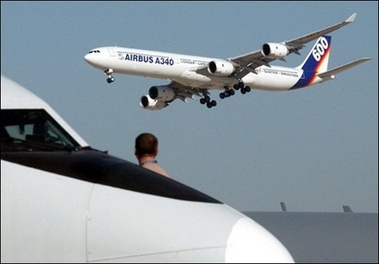PARIS - Leading European aerospace companies began working together on an
airline security project in 2004 and are making progress with systems to help
produce the first hijack-proof plane.

This file photo shows
a man looking up at an Airbus A340 as it flies overhead during a Dubai air
show. Leading European aerospace companies, including Airbus, have begun
working together on an airline security project in 2004 and are making
progress with systems to help produce the first hijack-proof
plane.[AFP] |
The SAFEE project, which stands for Security of Aircraft in the Future
European Environment, aims to create a series of technological innovations to
prevent "a repeat of September 11", says project coordinator Daniel Gaultier.
These include microphones and cameras to monitor passengers in the cabin,
digital fingerprints and iris scans for access to the cockpit, and an avoidance
system to prevent planes crashing into buildings.
All are designed to make hijacking an airliner in mid-flight virtually
impossible.
Not on the list, however, is the oft-mentioned idea of piloting planes from
the ground by remote control. Gaultier describes this as "futurism", noting that
it presents "huge difficulties in regulation and in securing the signal".
Instead, the 31 companies participating in SAFEE, launched in 2004 by the
European Commission, are looking at more viable alternatives.
Airbus, BAE Systems, Thales, Sagem and NLR have each taken charge of one of
five main initiatives.
In Hamburg, Germany in August, Airbus carried out the first tests on its
"threat detection system", which warns the pilot of any suspicious behaviour by
a passenger via a system of cameras and microphones. A full simulation is
planned for January 2008.
Thales, meanwhile, is working on an anti-collision system to be tested in
June 2007, Gaultier said.
Developing biometric fingerprinting to ensure that only crew members can
enter the cockpit has been entrusted to Dutch firm NLR, which plans to test the
system in August 2007 in Amsterdam.
Gaultier's company, Sagem Defense Securite, part of the Safran group, is
working on protecting data systems, in particular on communications between the
cockpit and control tower.
The total budget for SAFEE is 36 million euros, 19 million of which have been
put up by the European Commission.
The five companies involved in the project aim to give a joint demonstration
of their achievements in February 2008, "to show that it works", said Marco
Brusati, head of project at the European Commission.
After that, a new seven-year contract should be signed to bring the project
to completion. According to Brusati, "there will be no products on the market
before 2010. The whole package could be available on planes in operation from
around 2015."
Developing the new equipment poses legal and ethical as well as technological
problems. You cannot film passengers on board planes or record their
conversations except within a strict legal framework. But it is possible, says
Gaultier, "provided you destroy the recordings at the end of the flight."
The other stumbling block, Gaultier notes, is the "exorbitant" cost of
fitting the new technology to existing planes.
"Doubtless it would be better to think about incorporating them into the next
generation of aircraft," he says.